Franciscan Monastery of the Holy Land in America(1400 Quincy St. NE, Washington DC 20017). When you first enter the Upper Gardens at the Monastery, you can choose to explore the upper gardens to view the Rosary Portico, beautiful landscape, and the Portiuncula Chapel. Then explore the lower gardens, where you can pray the Stations of the Cross, visit replicas of the Grotto of Gethsemane, the Tomb of the Blessed Virgin Mary, the Lourdes Grotto, and more! Below is some helpful information, trivia, and challenges to accompany your pilgrimage through the gardens. Please Note: The lower gardens have some relatively steep areas and may not be appropriate for those with less mobility. There is good shade in most spots. During the pandemic, there are no bathrooms available to the public.
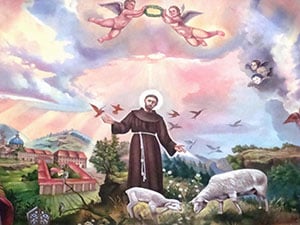 Reflect on the Life of St. Francis: When you first walk through the gates, in the rose gardens, you will see a statue of St. Francis of Assisi, founder of the Franciscans. To learn more about St. Francis you can read about him here or watch this video for a quick overview of St. Francis' life by Catholic News Agency.
Reflect on the Life of St. Francis: When you first walk through the gates, in the rose gardens, you will see a statue of St. Francis of Assisi, founder of the Franciscans. To learn more about St. Francis you can read about him here or watch this video for a quick overview of St. Francis' life by Catholic News Agency.
In St. Francis' early life, he was often described as the “Life of the Party”. He enjoyed a lavish, wild, and sinful lifestyle and desired greatly to be a noble knight. His story is one of the most powerful experiences of conversion, but it did not happen overnight. St. Francis found himself at a dead end: not satisfied by the worldly pleasures he sought out in his youth. (Photo Source: 2 Source: “Saint Francis of Assisi Church, Coyoacan, Federal District, Mexico019” by Enrique López-Tamayo Biosca is licensed with CC BY 2.0. The image can be found here)
Ask:Have you ever experienced a time when you were not satisfied by the things the world told you would bring you happiness (social media, parties, money, etc.)?
St. Francis only found fulfillment when he turned to Christ and gave himself to God. He lived a radical lifestyle: he chose to give up all his possessions for the simple life; showed honor, respect, and love to all people no matter their circumstance; and desired to spread the Gospel to every corner of the earth. It was this radical lifestyle that attracted thousands of people to travel to hear him speak and learn from his message. He placed absolute trust in the Lord to provide for his needs and those of his companions and through that trust, the Order of the Franciscans was born.
Ask: In what area(s) of your life do you need to allow yourself to have greater trust in the Lord?
Let us embrace the example of St. Francis as we journey on this encounter to radiate joy, embrace simplicity, and trust in the Lord.
Did you know? Our current Pope, Pope Francis, chose his name in honor of St. Francis of Assisi!
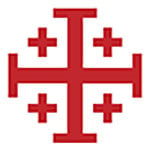 Jerusalem Cross
Jerusalem Cross
Near St. Francis' statue, you may notice a flag with a cross on it. This type of cross is called the “Jerusalem Cross” (also known as the “Crusaders' Cross”), which is thought by some to represent the four Gospels being carried to every corner of the earth while others believe it represents the wounds of Christ. The floor plan of the Main Church at the Franciscan Monastery is in the shape of a Jerusalem Cross. How many Jerusalem Crosses can you find during your tour?
Rosary Challenge
The upper gardens at the Franciscan Monastery has a Rosary Portico (covered walkway) with the Hail Mary written in 150 different languages. This display of prayer in various tongues shows the breadth and beauty of the universal Church. As you pray along the Rosary Portico and appreciate the beautiful imagery of Mary, can you identify 5 of the languages on display? Note: there are 15 small chapels along the route to represent 15 mysteries of the Rosary.
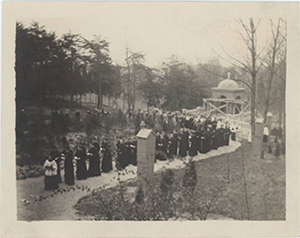 Stations of the Cross
Stations of the Cross
When visiting the Holy Land, a common practice is for pilgrims to participate in the “Via Dolorosa” (“Way of the Cross”) that follows a route of 14 stations throughout the Old City of Jerusalem. Each Friday the Franciscan Order leads a large procession throughout the city to pray through the path that Jesus took to his Crucifixion. At the Franciscan Monastery of the Holy Land in America, in the lower gardens, there are 14 station markers to observe this journey. There are many ways to pray through the stations. On this encounter, as you walk in Christ's footsteps, take the time to unite with Jesus' suffering by reflecting at each Station.
Together as a group or family, consider praying using one of these options to guide your Stations of the Cross experience:
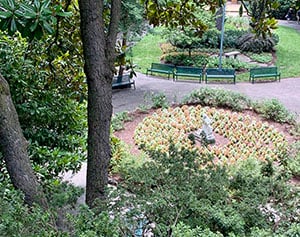 Lower Gardens
Lower Gardens
While you are in the gardens here are just some of the replicas that you can visit:
Grotto of Gethsemane...while at the Grotto, read Matthew 26: 36-46, the Agony in the Garden. It was at the Garden of Gethsemane that Jesus spoke with his Father while in the nearby Grotto the disciples had fallen asleep despite Jesus telling them to remain alert. He returned to find them asleep... “So you could not keep watch with me for one hour?... Watch and pray that you may not undergo the test. The spirit is willing, but the flesh is weak.” Perhaps you can ask those with you to reflect: What do you think the meaning of this passage is? How is it possible that the disciples could have fallen asleep? Would you have stayed awake for the Son of God...or would you have been tempted to say “oh, I can do that in the morning, I'm exhausted?” Are there any resolutions you can make to be vigilant in your own life?
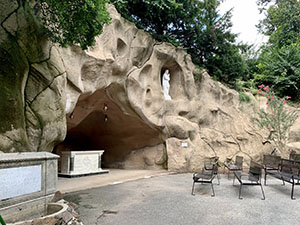 Tomb of the Blessed Virgin Mary...before the Blessed Mother's assumption into heaven, tradition says that upon her death she was kept in a tomb in a church at the foot of the Mount of Olives. The tomb on the grounds here is a replica of the one in Jerusalem. This is an excellent place to consider the sacrifices Mary made and the pain she must have endured seeing Jesus on the cross. After reflecting for a while, pray one or all of the following and consider what it means to say “yes” as Mary did: Hail Mary, Angelus, Hail Holy Queen, Magnificat, Memorare, Loving Mother of the Redeemer, Miraculous Medal Prayer (all may be found here: http://www.beginningcatholic.com/prayers-to-virgin-mary)
Tomb of the Blessed Virgin Mary...before the Blessed Mother's assumption into heaven, tradition says that upon her death she was kept in a tomb in a church at the foot of the Mount of Olives. The tomb on the grounds here is a replica of the one in Jerusalem. This is an excellent place to consider the sacrifices Mary made and the pain she must have endured seeing Jesus on the cross. After reflecting for a while, pray one or all of the following and consider what it means to say “yes” as Mary did: Hail Mary, Angelus, Hail Holy Queen, Magnificat, Memorare, Loving Mother of the Redeemer, Miraculous Medal Prayer (all may be found here: http://www.beginningcatholic.com/prayers-to-virgin-mary)
Lourdes Grotto...This replica of the site of a Marian apparition is also in the gardens.
Other points of interest include St. Anne's Chapel, St. Anthony and St. Jude, Ascension Chapel, Portiuncula Chapel (St. Francis' first church) and more!
If you wish to go on a deeper dive into the Monastery and the gardens please visit this link: https://wdchumanities.org/dcdm/files/original/2f86a7ce2f584ab1ac8cbb506d107b15.pdf
Trivia to Ask During Your Visit
- Who was the first pope since Saint Peter to visit the Holy Land? Pope Paul VI
- Who are the official guardians of the Holy Places? The Franciscans (Order of Friars Minor). It's critical to note that not only are they guardians of the sites but they also share Christ's message of hope and charity in word and deed through schools and service to those in need of all faiths and creeds.
- How far can a ten cent fundraiser go? Well, if you were creative, once upon a day, you could build an entire church! That's right, to fund the construction of the church at the Monastery, 2.5 x .5 inches paper bricks containing a medal of St. Anthony of Padua were sold for ten cents each! When the church was completed a year later the monastery was nearly debt free!
- What does bread have to do with St. Anthony? St. Anthony's Bread is the term used for offerings made in thanksgiving to God for blessings received through the prayers of St. Anthony. The practice of giving alms in honor of St. Anthony originated in the 13th century. For many devoted to the saint of Padua, St. Anthony's Bread is a means of ministering to the poor and disadvantaged. You may decide to make an offering to Franciscans of the Holy Land to feed the poor and, at the same time, to pay special tribute to St. Anthony, who dedicated so much of his life to the poorest and neediest.
- How is the retreat center for the Diocese of Arlington related to St. Francis of Assisi? The San Damiano Spiritual Life Center is named after the church that St. Francis helped to rebuild after his vision of the crucified Christ. St. Francis at first believed that in his encounter that Christ was calling him to “rebuild my house” his nearby church-literally to rebuild the church building at San Damiano that was in shambles. Later Francis saw it as a call to transform himself and the Church as a whole. For more information visit this link.
Ministry of the Franciscans
While on this pilgrimage, consider supporting the Franciscans who preserve the holy places and make it possible for Christians to remain in the land of Jesus. Below are some highlights of their ministry efforts:
- Working to stabilize the declining population of Christian families in the Holy Land who are threatened by national strife, terrorism, and the lack of employment and educational opportunities
- Preserving 74 sanctuaries and shrines from the life of Jesus and the prophets
- Operating 16 schools for more than 10,000 pre-K-12 students
- Supporting 29 parishes, 4 homes for orphans and 3 academic institutions
- Providing emergency support to refugees (Syrian, Iraqi, etc.)
The Franciscans also provide pilgrimage trips to the “real” Holy Land in Israel. If interested, visit https://holylandpilgrimages.org/.